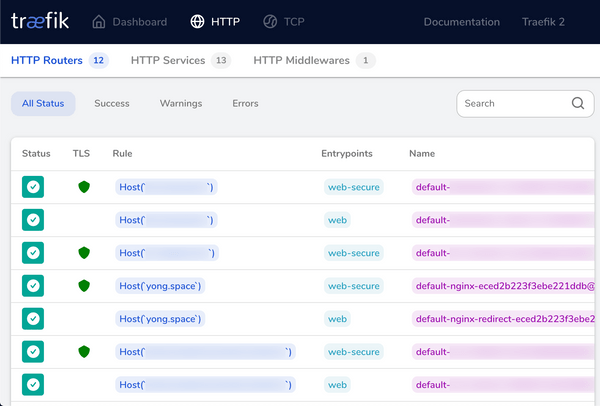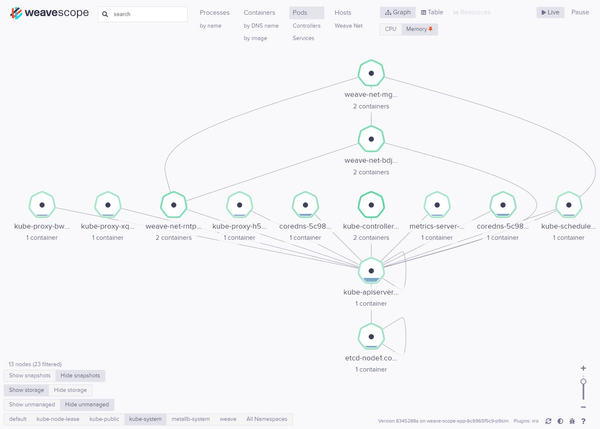Enhancing a Raspberry Pi Kubernetes Cluster
Apr 18th 2020, 3:51pm
9 min read
In the previous post, I described how to build a Kubernetes cluster of Raspberry Pi 4s from scratch. While you get an operational cluster that is fully capable of deploying basic workloads, it is vastly different to a managed cluster provided by a cloud vendor, simply because there is no cloud. Instead, you will have to find bare metal alternatives that hook into the same infrastructure.
Package Manager
This concept isn’t specific to a Raspberry Pi cluster, but Helm is a
nice utility to have for “app store”-like deployments that you can browse on Helm
Hub. They’ve changed out the architecture in v3, removing the need
for a dedicated Tiller pod that manages helm deployments, so all you now need is the
helm CLI. After installing the CLI, you’ll need to add repositories and update their
contents before you can install charts from them. For example, if you wanted to install
the nginx chart from stable:
helm repo add stable https://kubernetes-charts.storage.googleapis.com/
helm repo update
helm install nginx stable/nginxCaveat: At least that’s how it’s supposed to work in theory. In reality, most of the
charts you’ll find on Helm Hub are based on x86_64 images and do not support ARM out of
the box. You will most likely need to source for an image repo that supports multi-arch
including ARM and use the --set image.repository flag to override the image to pull.
Storage
Containers are meant to be transient with Persistent Volumes in Kubernetes being the solution for.. well, persistent storage. A cloud provider will easily provision storage from nowhere and bill you, but at home you’ll need to decide on storage medium. I personally already had a NAS so that decision was a no-brainer. Using a NAS for this requires creating a NFS share and the process will differ depending on your NAS vendor. I use Synology so I followed these instructions for their DSM panel.
After creating the NFS share, install the nfs-client-provisioner helm chart as follows.
Replace the NAS_IP and /path/to/nfs/share as appropriate. We’ll need to override the
repository here as the default one does not have an ARM binary.
helm install nfs-client-provisioner stable/nfs-client-provisioner \
--set nfs.server=NAS_IP \
--set nfs.path=/path/to/nfs/share \
--set image.repository=quay.io/external_storage/nfs-client-provisioner-armThe helm chart installs a storage class named nfs-client, which we’ll patch with a
is-default-class annotation so that all future persistent volume claims will
automatically use it.
kubectl patch storageclass nfs-client -p \
'{"metadata":{"annotations":{"storageclass.kubernetes.io/is-default-class":"true"}}}'To test this, we’ll create a simple persistent volume claim in test-pvc.yaml.
apiVersion: v1
kind: PersistentVolumeClaim
metadata:
name: test-pvc
spec:
accessModes:
- ReadWriteOnce
resources:
requests:
storage: 1GiThen apply it and check its status.
$ kubectl apply -f test-pvc.yaml
persistentvolumeclaim/test-pvc created
$ kubectl get pvc
NAME STATUS VOLUME CAPACITY ACCESS MODES STORAGECLASS AGE
test-pvc Bound pvc-a9.. 1Gi RWO nfs-client 6sIf you check the directory of the NFS share in your NAS, a new sub-directory named
default-test-pvc-pvc-a9.. will appear. You can now mount that claim in your deployment
and manage its contents from your NAS.
Load Balancers
When exposing a service on a deployment, there are a few types to choose from. ClusterIP
is for internal services while NodePort and LoadBalancer are for external-facing
services. Using NodePort forces you to specify the address of a specific node and use a
rather large port number (30000-32767) to access your service. Using LoadBalancer
typically assigns a random IP and routes traffic on the source port between the available
nodes.
Since we don’t have a cloud vendor to assign real external IPs, exposing services externally (to the Internet, not just the cluster) will first require an internal load balancer followed by some manual work on your router’s port forwarding configuration. This is only if you want to expose your services this way, which I do not recommend in favour of an ingress controller.
You can create dynamic internal load balancers using Metal LB. While the project disclaims itself as still being in beta, it has worked quite well for me. Obviously, there is a distinction between what personal and enterprise production means so weigh your own risks. Install Metal LB as follows:
METALLB_URL=https://raw.githubusercontent.com/metallb/metallb
kubectl apply -f $METALLB_URL/v0.9.3/manifests/namespace.yaml
kubectl apply -f $METALLB_URL/v0.9.3/manifests/metallb.yaml
kubectl create secret generic -n metallb-system memberlist \
--from-literal=secretkey="$(openssl rand -base64 128)"Before Metal LB is active, it requires a ConfigMap to define the protocol and IP range. In
the example below, I’m using layer2 for protocol since it is the simplest one that
doesn’t require any fancy routing equipment and I am providing a generous supply of 54 IPs
in my private network. Edit to your liking and kubectl apply -f.
apiVersion: v1
kind: ConfigMap
metadata:
namespace: metallb-system
name: config
data:
config: |
address-pools:
- name: default
protocol: layer2
addresses:
- 10.0.0.201-10.0.0.254To test this, we can expose any deployment, like the nginx from the previous post.
$ kubectl expose deployment nginx-deployment \
--port=80 --name=nginx-svc --type=LoadBalancer
service/nginx-svc exposed
$ kubectl get svc
NAME TYPE CLUSTER-IP EXTERNAL-IP PORT(S) AGE
nginx-svc LoadBalancer 10.99.57.130 10.0.0.202 80:30265/TCP 5sNotice it has used one IP from the configured pool and assigned a random node port which you can essentially ignore. Navigating to http://10.0.0.202 should show you the nginx welcome page now.
Ingress Controller
The preferred way of exposing services is via a centralised ingress controller that aside from routing traffic, also handles HTTPS termination. Again with cloud vendors, this is something you take for granted as it “just works” and you get a fancy web UI to inspect your configuration. Most (serious) people who replace their ingress controller or install their own would use nginx’s implementation. I wanted to try something different that also gave me a fancy UI so I went with Traefik.
You can follow the full installation guide
here. In short, what you need to do is
download the 01 to 04 yml files from their github
site.
The 01-crd.yml and 02-services.yml files can be deployed as-is. 01-crd.yml creates
the cluster role bindings and custom resource definitions. 02-services.yml creates
Traefik’s own services - I amended the web service to be LoadBalancer later on so that
I have easier access to the dashboard.
In 03-deployments.yml, you will need to amend the args block to add your Let’s Encrypt
email and change the location of acme.storage to a PVC mount.
- args:
# ...
- --certificatesresolvers.default.acme.email=your_email@domain.com
- --certificatesresolvers.default.acme.storage=/lets-encrypt-data/acme.json
# ...
volumeMounts:
- mountPath: /lets-encrypt-dat
name: lets-encrypt-data
# ...
volumes:
- name: lets-encrypt-data
persistentVolumeClaim:
claimName: lets-encrypt-dataThen create the PVC with a matching name to store Let’s Encrypt data.
apiVersion: v1
kind: PersistentVolumeClaim
metadata:
name: lets-encrypt-data
spec:
accessModes:
- ReadWriteOnce
resources:
requests:
storage: 1Gi04-ingressroutes.yml is a sample of how to define a Traefik IngressRoute. You should
amend this and link it to your own deployment. I use two types of IngressRoutes - one for
TLS termination and the second to redirect non-TLS traffic. The redirection uses a
middleware CRD that you have to add yourself.
apiVersion: traefik.containo.us/v1alpha1
kind: Middleware
metadata:
generation: 2
name: redirect
spec:
redirectScheme:
permanent: true
port: 443
scheme: httpsThis is the TLS IngressRoute using the web-secure entryPoint. Note that the
certResolver name must match the args in your 03-deployments file.
apiVersion: traefik.containo.us/v1alpha1
kind: IngressRoute
metadata:
name: nginx-ingressroute
spec:
entryPoints:
- web-secure
routes:
- kind: Rule
match: Host(`yong.space`)
services:
- name: nginx
port: 80
tls:
certResolver: default
options: {}and this is the other IngressRoute listening on the web entryPoint (port 80) that will
use the redirect middleware to forward visitors to the HTTPS version above.
apiVersion: traefik.containo.us/v1alpha1
kind: IngressRoute
metadata:
name: nginx-ingressroute-redirect
spec:
entryPoints:
- web
routes:
- kind: Rule
match: Host(`yong.space`)
middlewares:
- name: redirect
services:
- name: nginx
port: 80Once you have kubectl applied everything and they start up, you should be able to access
the dashboard on the web service. Mine looks like this:

Network Dashboard
One somewhat annoying thing about managing many different assets in a cluster is that you can’t really tell what the state of your entire cluster is at a glance. You can list deployments, PVCs, describe pods with individual kubectl commands but it simply takes too long to get a sense of things from a high level. Fret not, because Weave, the network overlay used in this cluster, has a tool called Weave Scope. It uses the network overlay to extract metrics of your cluster, visualising the entire thing in a cool dashboard. You can even inspect cpu/memory usage at a pod level and follow container logs within the web interface.
Unfortunately, Weave doesn’t officially support ARM so I am relying on the good work of
this gentleman, Carlos Eduardo, who has kindly built a
version of scope targeted for ARM64. All you need to do is kubectl apply -f his yamls
available on his GitHub
site.
SCOPE_URL=https://raw.githubusercontent.com/carlosedp/kubernetes-arm/master
kubectl apply -f $SCOPE_URL/7-WeaveScope/1-scope.yaml
kubectl apply -f $SCOPE_URL/7-WeaveScope/2-scope-ingress.yamlThis is what my kube-system namespace looks like visualised.

Go Live
Now the cluster is in a better state to run some actual workloads. I’ve experimented with many other things that simply didn’t work or had extremely poor support for ARM. A lot of cool projects are geared towards actual server hardware (i.e. x86_64) or do not have a scaled-down version that will run on tiny Pi nodes. Therefore quite a number of things I wanted to try like Istio, ELK or Prometheus/Grafana didn’t get very far. Oh well, this is what I have to work with now until a critical mass decides otherwise on how they feel about ARM.
Do you know any other interesting solutions that work on Pi clusters which I missed out on? Let me know on Twitter!